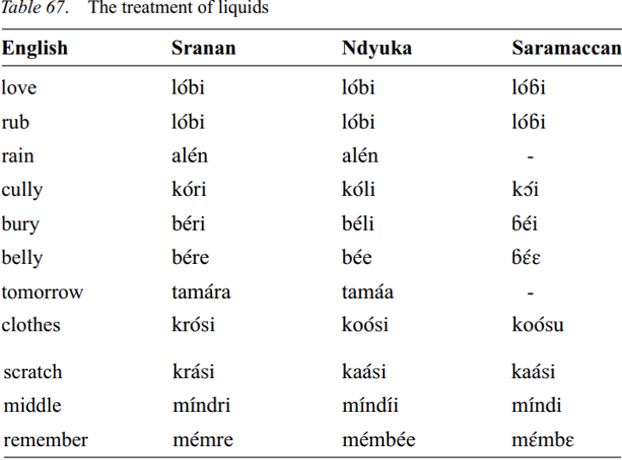


 Grammar
Grammar
 Tenses
Tenses
 Present
Present
 Past
Past
 Future
Future
 Parts Of Speech
Parts Of Speech
 Nouns
Nouns
 Verbs
Verbs
 Adverbs
Adverbs
 Adjectives
Adjectives
 Pronouns
Pronouns
 Pre Position
Pre Position
 Preposition by function
Preposition by function 
 Preposition by construction
Preposition by construction
 Conjunctions
Conjunctions
 Interjections
Interjections
 Grammar Rules
Grammar Rules
 Linguistics
Linguistics
 Semantics
Semantics
 Pragmatics
Pragmatics
 Reading Comprehension
Reading Comprehension|
Read More
Date: 2024-04-20
Date: 2024-12-02
Date: 2024-02-17
|
In general there are three Suriname-internal developments concerning liquids.
Firstly, a tendency to neutralize the distinction between /l/ and /r/. In Ndyuka and Saramaccan the result is always /l/. In Sranan we see a more complex near-neutralization. “Near-neutralization”, because the process is not totally complete. Word-internally liquids go to [r], and initially to [l]. The first liquid also goes to /l/ if pre-stress, even if a vowel precedes.
Secondly, a tendency to lose word-internal liquids altogether in Ndyuka and Saramaccan. In Ndyuka intervocalic liquids tend to be preserved only if the surrounding vowels are different; they are lost if the vowels are identical. Word-internal liquids are virtually always lost in Saramaccan, except in recent loanwords. Clusters were epenthesized away, followed by loss of the liquid in Ndyuka and Saramaccan.

The third tendency is one of liquefaction of word-internal /d/’s following earlier liquids. This is nowadays restricted to Ndyuka and Saramaccan, although in older Sranan recordings it makes a sporadic appearance. As we can see, subsequent /l/- loss has virtually removed the resultant liquid in Saramaccan.

|
|
|
|
دخلت غرفة فنسيت ماذا تريد من داخلها.. خبير يفسر الحالة
|
|
|
|
|
|
|
ثورة طبية.. ابتكار أصغر جهاز لتنظيم ضربات القلب في العالم
|
|
|
|
|
|
|
قسم شؤون المعارف ووفد من جامعة البصرة يبحثان سبل تعزيز التعاون المشترك
|
|
|